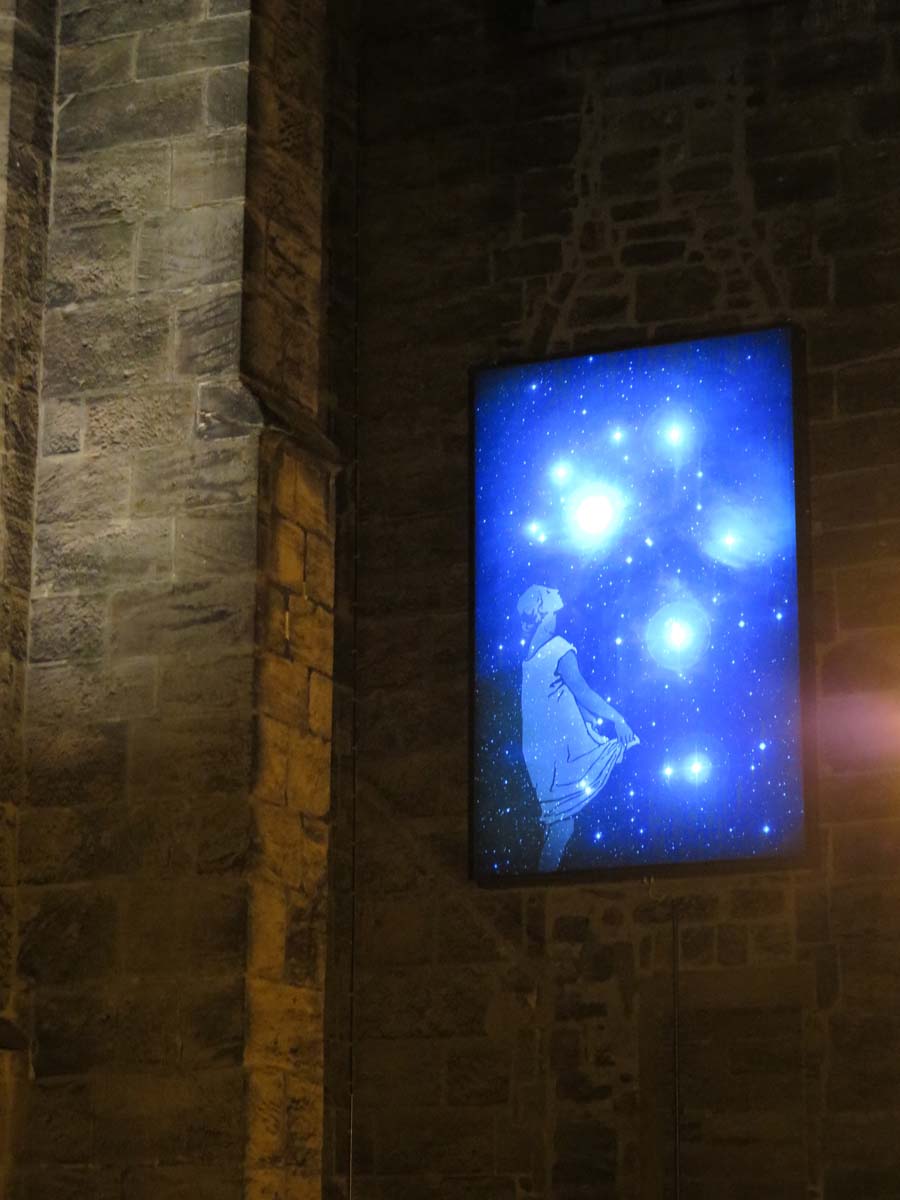My German readers currently have the opportunity to visit an exhibition called Macht! Licht! at the Kunstmuseum Wolfsburg. The title is ambiguous – it could mean “Turn on the Light!” or “Power!Light!” The latter English translation is also ambiguous: power can refer to electricity per se, or to the uses of electric light in the context of surveillance, monitoring, torture or even destruction. (Ab)using power in the political sense.




You figure out how I took these photos of my shadow….
A description of the exhibitions contents:
Based on selected works from the collection of the Kunstmuseum Wolfsburg, a fascinating spectrum of works of light art is presented in the darkened hall of the museum, the conceptual levels of reflection of which focus on the following (socio-)political areas: utopia/dystopia; ecology/biology; economics; violence/power; control/monitoring; advertising/manipulation; enlightenment/obfuscation; border/exclusion; public space etc.
I have obviously not seen the exhibition, but was made curious by one of the projects that is mentioned in the write-ups of the show. A collaborative team of artist Nana Petzet and biologist(s) explore the unintended consequences of artificial light used in cultural contexts – light shows during outside concerts, public nighttime events, festivals of light, etc.

Old Elbtunnel,Hamburg



Portland Airport

Parking Lot Boston, MA
The project, stretched across some years, was called Lichtfalle Hamburg (Light Trap – the link can be read in English.) It mimicked (in greatly reduced fashion with a single boat) the conditions of blue light that the City of Hamburg uses during Harbor festivals that illuminate the public landscape and night sky.

Photocredit: Helge Mundt
(“Cruise Days” they are called. It is one of those festivals, where 12,000 light sources – mostly blue fluorescent tubes – are strung in the port area and the HafenCity. Over a period of five weeks, with the aid of 40 km of cables and a team of 40 assistants, they were mounted onto buildings, quay sections, cranes, jetties, pontoons, launches, ferries, tugboats, docks, operational vehicles, trees, bridges etc.)

Photocredit: Hamburger Hafen Marketing
What would the light do to insect populations? The team counted and observed the behavior of about 16 orders of insects, moths among them but also large swarms of dayflies that usually hover above the river. Surprise, the results were of great concern. Insects are attracted to these light sources and fly around them to the point of such exhaustion that they don’t find their way home, basically dying in situ – something called the “vacuum cleaner effect. The land on surfaces and dry out, when exhausted, unable to reproduce before their death.




Hamburg Elbphilharmonie
This matters tremendously for pollination in times when we already see a huge reduction in numbers of insects due to destroyed habitats and shifts in temperatures that many species cannot adapt to. In other words, those lovely evenings celebrated with light, lifting our spirits, have truly bad consequences for agricultural environments


Old Elbtunnel, Hamburg – San Francisco Airport
Light pollution is often mentioned in terms of disrupting sleep patterns in humans and flight patterns for migratory birds, leading to huge losses there as well. We now have to add insect to the list. Here is a short intro to light pollution by National Geographic, Light Pollution 101. It discusses the problem of waste of energy as well.



Hamburg Elbphilharmonie – Hamburg Harbor Water Recycling Plant
Here in Portland, OR we have the annual Winter Light Festival that brings light art to the river for a short period of time, and the Willamette Light Brigade, who, in their words, harness the power of artful lighting to transform the cityscape by lighing bridges and advocating for the importance of night-time identity and place-making. There is WinterFest with light art in Central Oregon, and there are numerous night markets around the year that add extra lighting to city scapes that have already a high dose of light pollution through street lighting and shops windows etc.



Staircase in Ljubljana, Slovenia
For those interested what daily excessive use of light in a regular manner does to our environment, here is a relatively recent article in Nature that shows ho much research is going on in the environmental and ecological sciences. Truly interesting. And here are pictures of Portland’s light pollution and a link to the International Dark Sky Week 2022 (April 22 -30) that gives tips about how to reduce light pollution in our own households.
Photographs today are of instances where my eyes got caught by light patterns, inside as well as outside. Some of these are from Hamburg, where the Light Trap project took place.



Staircase in Paula Modersohn Becker Musem in Bremen – Stage scenery in Portland Armory
We have for the longest associated light with something positive. It offers protection, carves out social spaces, secures movement at night. Light art certainly has an enthusiastic following. It looks like we need to ask some serious questions about what the consequences are and was we are willing or should sacrifice in order to pay environmental protection more than lip service.




Advert in San Francisco – Art in Montreal – Lit Sign at RISD in Providence, Rhode Island
Here is a video that shows some of the work shown in Macht!Licht! and some other European light art. The language is German, but the images speak for themselves, Guantanomo reconstruction of a white torture chamber included.

Frei Hafen Hamburg
And here is Hamburg’s son, Brahms, played at the Elbphilharmonie – the building in some of the photos above. Pink lights and all….





